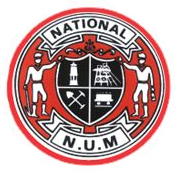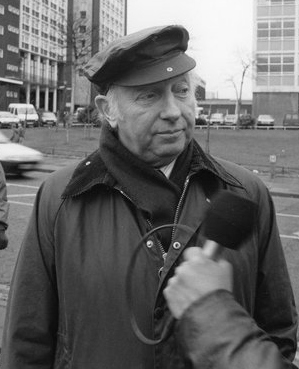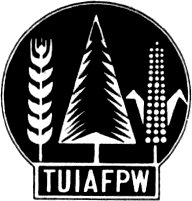Related Research Articles

The World Federation of Trade Unions (WFTU) is an international federation of trade unions established on October 3, 1945. Founded in the immediate aftermath of World War Two, the organization built on the pre-war legacy of the International Federation of Trade Unions as a single structure for trade unions world-wide, following the World Trade Union Conference in London, United Kingdom.

The National Union of Mineworkers (NUM) is a trade union for coal miners in Great Britain, formed in 1945 from the Miners' Federation of Great Britain (MFGB). The NUM took part in three national miners' strikes, in 1972, 1974 and 1984–85. Following the 1984–85 strike, and the subsequent closure of most of Britain's coal mines, it became a much smaller union. It had around 170,000 members when Arthur Scargill became leader in 1981, a figure which had fallen in 2023 to an active membership of 82.

Arthur Scargill is a British trade unionist who was President of the National Union of Mineworkers (NUM) from 1982 to 2002. He is best known for leading the 1984–1985 UK miners' strike, a major event in the history of the British labour movement.

The World Federation of Teachers Unions is the Trade Union International (TUI) branch of the World Federation of Trade Unions representing educators.

The Trade Union International Public Service and Allied is a section of the World Federation of Trade Unions representing public sector workers.
The Trade Union International of Transport Workers (TUI-TRANSPORT) is a sectoral federation of workers in the transport industry, affiliated with the World Federation of Trade Unions. It was formerly known as the Trade Unions International of Transport, Port and Fishery Workers.

The Trade Union International of Building, Wood, Building Materials and Allied Industries, also known as the Trade Union International of Construction, Wood, Building Materials and Allied Industries, more commonly known by its French acronym UITBB is a trade union international affiliated with the World Federation of Trade Unions.
The Trade Union International of Workers in the Mining, the Metallurgy and the Metal Industries is a trade union international affiliated with the World Federation of Trade Unions.
The Trade Union International of Food, Tobacco, Hotel and Allied Industries Workers was a trade union international affiliated with the World Federation of Trade Unions.
The Trade Union International of Workers in Commerce was a trade union international affiliated with the World Federation of Trade Unions.
The Trade Union International of Textile, Leather and Fur Workers Unions was a trade union international affiliated with the World Federation of Trade Unions.

The Trade Unions International of Chemical, Oil and Allied Workers was a trade union international affiliated with the World Federation of Trade Unions. It was often known by its French initials, ICPS.
The Trade Union International of Workers in the Metal Industry was a trade union international affiliated to the World Federation of Trade Unions.

The Trade Union International of Agricultural, Forestry and Plantation Workers was a trade union international affiliated with the World Federation of Trade Unions.
The Standing Committee of Trade Unions in the Graphic Industry, also known as the Permanent Committee Graphic Arts Unions, was an international trade union federation for workers in the graphic arts industry.

The Miners' International Federation (MIF), sometimes known as the International Federation of Miners, was a global union federation of trade unions.
The International Federation for the Graphical Industries was a global union federation bring together trade unions representing printing workers.
The International Federation of Christian Miners' Unions was a global union federation bringing together trade unions representing workers in the mining industry.
The World Federation for the Metallurgic Industry was a global union federation representing workers in the metalworking industry.
The World Federation of Energy, Chemical and Various Industry Workers' Unions was a global union federation bringing together unions representing workers in a variety of industries.
References
- ↑ The World Federation of Trade Unions, 1945-1985. Prague; Published by the WTFU in cooperation with PRACE Czechoslovak Trade Unions 1989 p.194
- ↑ Ronald Payne and Gary Busch, "Scargill goes international", The Spectator , 30 November 1985
- ↑ Project for Articles of Association p.16
- ↑ Project for Articles of Association p.16
- ↑ Coldrick, A. Percy and Jones, Philip. The international directory of the trade union movement New York : Facts on File, [1978] p.204
- ↑ Coldrick and Jones p.194
- ↑ The World Federation of Trade Unions, 1945-1985 p.154
- ↑ Directory of World Federation of Trade Unions Washington Office of International Labor Affairs, June 1955 pp.47-8
- ↑ Facts about international Communist front organisations p.32
- ↑ Coldrick and Jones p.195
- ↑ Upham, Martin Trade unions of the world, 1992-1993. Harlow, Essex, U.K. : Longman; Detroit, Mich. : Distributed exclusively in the U.S. and Canada by Gale Research Inc., 1991 p.558
- ↑ Miners' International News.
- ↑ Coldrick and Jones p.195
- ↑ Coldrick and Jones p.195
- ↑ The World Federation of Trade Unions, 1945-1985 p.155
- ↑ Miners of the world
- ↑ Proch, Franciszek; Ziffer, Bernard (Winter 1960). "POLAND IN 1959: CHRONICLE OF EVENTS July 1, 1959 — December 31, 1959". The Polish Review. 5 (1).